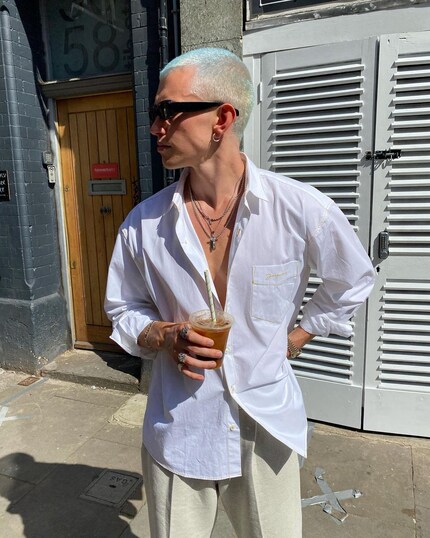
Background information
A visit to Dirtlej, home of the legendary dirtsuit
by Patrick Bardelli

Women button from the left, men from the right. That’s the status quo. But why? You can find tons of theories on the Internet, but most of them are nonsense.
Although I really just wanted to know why the buttons on almost all my blouses, cardigans and blazers are sewn onto the left side, I quickly found myself knee-deep in theories involving late medieval sword fights, hungry babies and stormy rides in side saddles.
It all started with the book «The Hidden Facts of Fashion». This book made me aware – after 27 years of ignorance – that the placement of buttons on clothing signals which gender an article of clothing was designed for. Buttons on the right: men or unisex. Buttons on the left: women. The book explains that placing the buttons on the right side makes it easier for the majority of people – who are right-handed – to button their clothing. But what about us females?


According to the book, buttons were first used as a fastener, rather than as a purely decorative element, in 13th-century Europe. At this time, wealthy women were not in the habit of dressing themselves. For this, there were maids – who would’ve found it much easier (considering they’d be facing their mistresses) to fasten buttons located on the left of their mistress’ clothing. That the upper classes at that time would’ve shown such consideration for servants seems quite questionable to me. As does the assertion that the side the buttons are on makes dressing noticeably easier. So I scoured the Internet for further explanations – and lucky me – found several. But these seem even more absurd.
Until the 20th century, women had to ride sidesaddle, with both legs to the left. One widespread theory suggests that buttons were thus moved to the left, to prevent the driving wind from blowing head-on into the garment’s opening. Seriously? If so, I can’t help but wonder if wearing an undershirt wouldn't have been a better solution. Not to mention that in those days of the corset craze, fashion most assuredly didn't centre around a rider’s comfort.
Another theory stresses that most mothers hold their babies in the left arm. Accordingly, a blouse with a button on the left is easier to open when breastfeeding. I put a wine bottle on my arm as a substitute for a real baby while trying clothing with buttons on one side then the other and realised... there’s absolutely no difference. Only one thing is certain – if I don’t find an expert to help me navigate this web of obscure theories soon, buttons are going to haunt me in my sleep.
I therefore turned to specialist lecturer Andrea Krieg, who teaches modules such as «Fashion History» at the STF Swiss Textile College. Right from the beginning, she clarified: «To this day, I have not found a single historical record that provides a clear rationale.» So in the end we can only ever speculate as to the reasoning behind the differences in button placement – with some explanations seemingly more sound than others. Krieg, too, considered the above-mentioned theories to be «rather unconvincing».
However, one theory that is believable suggests the placement of buttons on men's clothing goes back to sword-fighting. «Weapons were carried on the left side of the body and drawn with the right hand. To prevent a man from catching the opening of his garment, buttons were sewn on the right side.» Another advantage, which Napoleon was known to be a fan of, was that a man could easily slide his fighting hand through the opening of the garment and keep it warm against his body. Sounds plausible. But what about us females?
«The practice of using buttons for women’s clothing didn’t become established until much later,» explained Andrea Krieg. «Historical illustrations show that dresses were still being laced onto women in the late Middle Ages. At that time, buttoned jackets were already appearing on men.» Of much significance was that women's clothing was being increasingly modelled after men's clothing from the 19th century onward. «Button placement determined which product was intended for which gender.»
So it’s as simple as that. Although we’d have to travel back centuries to solve the button mystery, this latest explanation is still applicable today, unlike that of side saddles and ladies-in-waiting. The proverbial label still doesn’t always come in the form of a tag.
Header image. Pia Seidel
Has endless love for shoulder pads, Stratocasters and sashimi, but a limited tolerance for bad impressions of her Eastern Swiss dialect.
Interesting facts about products, behind-the-scenes looks at manufacturers and deep-dives on interesting people.
Show all
Background information
by Patrick Bardelli

Background information
by Michael Restin

Background information
by Stephanie Vinzens